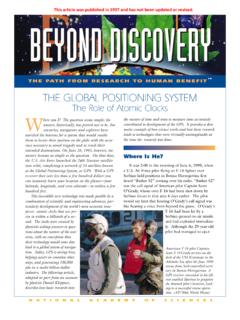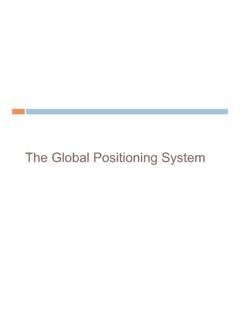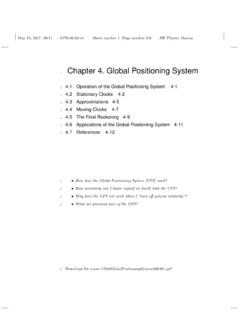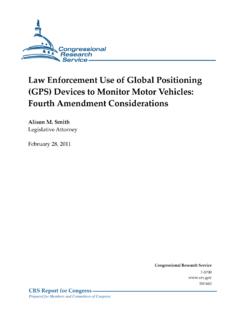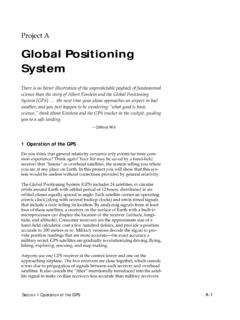Transcription of Global Positioning System - Brian Arnall
1 SOIL 4213 Global Positioning System Wesley M. Porter GPS Three Segments: Space Control User Space Segment Satellite constellation consisting of approximately 31 satellites in 6 orbital planes (currently 30 operational). The satellites are identified by space vehicle number (SVN) or pseudo random noise (PRN). With the constellation geometry, 4-10 satellites can be seen anywhere in the world with an elevation of at least 10 . Have an orbital altitude of about 12500 miles. Clear of the atmosphere so they will orbit according to very simple mathematics.
2 Space segment provides ranging signals and data messages to user equipment. The satellites have a nominal orbital period of ~12 hours. Control Segment Consists of three parts: Monitor Stations, Ground Antennas, and the Master Control Station. Monitor stations are remotely operated. They track and monitor the GPS satellites, checking both their operational health and their exact position in space. There are five such stations: Hawaii, Ascension Island, Diego Garcia, Kwajalein, and Colorado Springs. Positions are precisely known and stations are equipped with dual frequency receivers logging both L1 and L2 signals.
3 The master ground station transmits corrections for the satellites ephemeris constants and clock offsets back to the satellites themselves. The satellites can then incorporate these updates in the signals they send to GPS receivers. Errors in orbit are measured, corrected for, and sent back to the satellite by the DOD to increase the accuracy. User Segment (Receivers) Provides navigation, guidance, surveying, tracking, etc. On the ground all GPS receivers have an almanac programmed into their computers that gives them real-time satellite location.
4 GPS Signals GPS measurements contain errors and biases, which can be removed or minimized by combining various GPS observables (signals). The signal structure comes in the form of a microwave radio signal composed of two carrier frequencies (sine waves). Using two signals (different frequencies) allows correction for ionospheric delays. GPS Signals The Pseudo Random Noise/Code (PRN or PRC) is a fundamental part of GPS. It is a complicated sequence of on and off pulses. This signal is so complicated that it almost looks like random electrical noise.
5 The complex pattern helps ensure the receiver doesn t accidentally sync to another signal. Since each satellite has its own unique PRN the complexity guarantees that the receiver will not accidentally pick up another satellite s signal, so all of the satellites can use the same frequency without jamming each other. The other reason for the complexity of the PRC, is that it s crucial to making GPS economical. The codes make it possible to use information theory to amplify the signal, thus the receivers do not require large dishes to receive the signal.
6 GPS Signals-Carriers The L1carrier is MHz and carries both the status message and a pseudo-random code for timing. It has a wavelength of 19 cm ( inches). The L2 carrier is MHz and is used for the more precise military pseudo-random code. It has a wavelength of cm ( inches). GPS Signals-PRC There are two types of PRC. This first is called the C/A (Coarse Acquisition) code. It modulates the L1 carrier. It repeats every 1023 bits and modulates at a MHz rate (Mbps). The C/A code is the basis for civilian GPS use. The second PRC is called the P (Precise) code.
7 It repeats on a 7-day cycle and modulates both the L1 and L2 carriers (P1 and P2) at a MHz rate. This code is intended for military users and can be encrypted (Y code). GPS Signals-Navigation Message There is a low frequency signal added to the L1 codes that gives information about the satellite s orbits, their clock corrections and other System status. Transmission of the complete message takes minutes. GPS Signals-Pseudo range Measurements Pseudorange is a measure of the range between the satellite and receiver. These ranges are used to locate the receiver via trilateralization.
8 Either P or C/A code can be used. It is called pseudo range because we know it contains errors and is thus not the true range. GPS Signals: Code-Phase GPS vs. Carrier-Phase GPS Code-Phase and Carrier-Phase refer to the particular signal that we use for timing measurements. The primary method is code phase, but the carrier frequency can significantly improve accuracy. A GPS receiver determines the travel time of a signal from a satellite by comparing the pseudo random code it s generating, with an identical code in the signal from the satellite.
9 GPS Signals: Code-Phase GPS vs. Carrier-Phase GPS The receiver slides its code later and later in time until it syncs up with the satellite s code. The amount it has to adjust the code is equal to the signal s travel time. The problem is that sometimes you can move a signal half a cycle and the signals would still logically match up. Due to this error code-phase GPS can have an error of up to 300 meters. Luckily receiver designers have ways to ensure the signals are almost perfectly in phase. Good machines can get within a percent or two, but that can still be around 3 to 6 meters of error.
10 GPS Signals: Carrier-Phase GPS Higher accuracy receivers beat the System by starting with pseudo random code and then move on to measurements based on the carrier frequency. The carrier frequency is much higher so its pulses are closer together thus it is more accurate. If we could get within one percent of perfect phase like we do with code-phase receivers then we could have 3 to 4 millimeter accuracy. GPS Signals: Carrier-Phase Challenges This method is just counting the exact number of carrier cycles between the satellite and the receiver.

